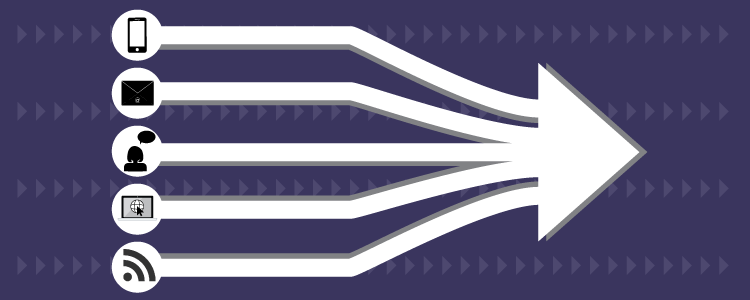Chances are, you’re very familiar with this brand. You might have watched one of their movies, listened to their music, bought a t-shirt (or pair of Mickey ears *hint, hint*), or even gone to visit. That’s right, the 2016 World’s Most Powerful Brand is Disney. I recently took a trip to Disney World and got to see their award-winning brand in action. This truly is a brand that plans their magic down to every detail so that all aspects of their multi-channel marketing are integrated and result in the best experience possible.
Similarly, your brand can also benefit from this integrated approach. Multi-channel marketing is a marketing approach that uses a variety of channels to reach an intended audience across multiple campaigns or within a singular, multi-level campaign. Examples of marketing channels include email marketing, social media, direct mail, SMS, or website activity. The main objective of running multi-channel marketing campaigns is to increase reach to prospects and customers and make it easier for them to engage with your campaign.
Disney exemplifies what a unified brand can be and demonstrates these great tips for better multi-channel marketing:
- Know your audience and design for them. This boils down to a strong understanding of your buyer personas. Who are they? What are they interested in? What keywords are they searching for and what social media platforms are they using? Knowing who you are targeting allows you to be more successful in creating a message they will relate to. I definitely don’t need to convince you that Disney does a fantastic job of this- just look at any child’s wardrobe.
- Reach your audience where they’re at. This is where the “multi-channel” part plays a big role. If you know your personas spend a lot of time on Facebook, then target them more on Facebook. Don’t bother wasting time on social media sites that aren’t reaching your intended audience. If you know certain social sites are the most popular, engage with them as much as possible through all of your communications. For example, consider adding social media content in your emails.
- Tell a story. Facts and figures just aren’t as relatable or memorable as stories are to us. Weaving a story throughout your various marketing channels creates a consistent brand image and message that is likely to resonate with your audience. Consider the perspectives of your personas and focus on what they care about and are interested in. Then, take this key message and make sure it’s telling the same story throughout all of your communications regardless of channel.
- Entertain all the way through. If you’ve been to Disney, you might have noticed that the lines you wait in aren’t like lines at most theme parks. In fact, Disney spends a lot of time engineering the queue line to entertain their target audience and to engage with them before the main attraction. Likewise, your multi-channel communications need to entertain your audience all the way through. If you are moving them across platforms, make the journey seamless for them. Nurture your leads with the content they’re interested in and identify gaps in your marketing materials to help make the whole lifecycle journey engaging.
- All lines get you to the same place. One of the most important pieces of a multi-channel marketing campaign is creating an overall flow to nurture your leads and move them through their lifecycle stages with your brand. You need to know what material is being released when, and how it plays into your overall strategy. All channels need to result in the same end goal, just like getting in any line for “It’s a Small World” gets you on the same boat ride.
- Know what’s working. As with any marketing campaign, it’s important to analyze and define the return on investment (ROI) of each channel, ideally measured by tracking engagement levels, which encourage marketing influenced leads and conversion of sales. Knowing which channels were effective, which channels influenced other channels, and which channels didn’t convert allows you to optimize future multi-channel marketing strategies.
Taking these tips into consideration when creating your multi-channel marketing strategy enables your company to create some magic of its own!

